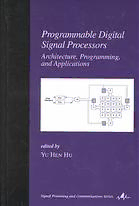Table Of ContentProgrammable Digital
Signal Processors
Architecture, Programming,
and Applications
edited by
Yu Hen Hu
University of Wisconsin–Madison
Madison,Wisconsin
Marcel Dekker, Inc. New York Basel
•
TM
Copyright ©2001 by Marcel Dekker,Inc. All Rights Reserved.
ISBN: 0-8247-0647-1
Thisbookisprinted onacid-freepaper.
Headquarters
MarcelDekker,Inc.
270MadisonAvenue,New York,NY 10016
tel:212-696-9000;fax:212-685-4540
EasternHemisphereDistribution
MarcelDekkerAG
Hutgasse4,Postfach812,CH-4001Basel, Switzerland
tel:41-61-261-8482;fax: 41-61-261-8896
World WideWeb
http://www.dekker.com
The publisher offers discounts on this book when ordered in bulk quantities. For more
information, write to Special Sales/Professional Marketing at the headquarters address
above.
Copyright2002 byMarcelDekker,Inc. AllRights Reserved.
Neitherthisbook norany partmay bereproducedortransmittedinany formorbyany
means, electronic or mechanical, including photocopying, microfilming, and recording,
or by any information storage and retrieval system, without permission in writing from
thepublisher.
Currentprinting (lastdigit):
10 9 8 7 6 5 4 3 2 1
PRINTEDINTHEUNITEDSTATESOFAMERICA
Series Introduction
Over the past 50 years, digital signal processing has evolved as a
major engineering discipline. The fields of signal processing have
grown from the origin of fast Fourier transform and digital filter
design to statistical spectral analysis and array processing, image,
audio, and multimedia processing, and shaped developments in high-
performance VLSI signal processor design. Indeed, there are few
fields that enjoy so many applications—signal processing is
everywhereinourlives.
When one uses a cellular phone, the voice is compressed, coded,
andmodulatedusingsignalprocessingtechniques.Asacruisemissile
winds along hillsides searching for the target, the signal processor is
busy processing the images taken along the way. When we are
watching a movie in HDTV, millions of audio and video data are
being sent to our homes and received with unbelievable fidelity.
When scientists compare DNA samples, fast pattern recognition
techniques are being used. On and on, one can see the impact of
signal processing in almost every engineering and scientific
discipline.
Because of the immense importance of signal processing and the
fast-growing demands of business and industry, this series on signal
processing serves to report up-to-date developments and advances in
the field. The topics of interest include but are not limited to the
following:
·
Signaltheoryandanalysis
·
Statisticalsignalprocessing
·
Speechandaudioprocessing
·
Imageandvideoprocessing
·
Multimediasignalprocessingandtechnology
·
Signalprocessingforcommunications
·
SignalprocessingarchitecturesandVLSIdesign
v
Signal Processing and Communications
EditorialBoard
MauriceG.Ballanger,ConservatoireNational
desArtsetMétiers(CNAM),Paris
EzioBiglieri,PolitecnicodiTorino,Italy
SadaokiFurui,TokyoInstituteofTechnology
Yih-FangHuang,UniversityofNotreDame
NikhilJayant,GeorgiaTechUniversity
AggelosK.Katsaggelos,NorthwesternUniversity
MosKaveh,UniversityofMinnesota
P.K.RajaRajasekaran,TexasInstruments
JohnAastedSorenson,ITUniversityofCopenhagen
1. Digital Signal Processing for Multimedia Systems, edited by Keshab
K.ParhiandTakaoNishitani
2. Multimedia Systems, Standards, and Networks, edited by Atul Puri
andTsuhanChen
3. Embedded Multiprocessors: Scheduling and Synchronization, Sun-
dararajanSriramandShuvraS.Bhattacharyya
4. SignalProcessingforIntelligentSensorSystems,DavidC.Swanson
5. CompressedVideooverNetworks,editedbyMing-TingSunandAmy
R.Reibman
6. ModulatedCodingforIntersymbolInterferenceChannels,Xiang-Gen
Xia
7. Digital Speech Processing, Synthesis, and Recognition: Second Edi-
tion,RevisedandExpanded,SadaokiFurui
8. ModernDigitalHalftoning,DanielL.LauandGonzaloR.Arce
9. BlindEqualizationandIdentification,ZhiDingandYe(Geoffrey)Li
10. Video Coding for Wireless Communication Systems, King N. Ngan,
ChiW.Yap,andKengT.Tan
11. Adaptive Digital Filters: Second Edition, Revised and Expanded,
MauriceG.Bellanger
12. Design of Digital Video Coding Systems, Jie Chen, Ut-Va Koc, and
K.J.RayLiu
13. Programmable Digital Signal Processors: Architecture, Program-
ming,andApplications,editedbyYuHenHu
14. Pattern Recognition and Image Preprocessing: Second Edition, Re-
visedandExpanded,Sing-TzeBow
15. Signal Processing for Magnetic Resonance Imaging and Spectros-
copy,editedbyHongYan
16. SatelliteCommunicationEngineering,MichaelO.Kolawole
AdditionalVolumesinPreparation
Preface
Since their inception in the late 1970s, programmable digital signal processors
(PDSPs) have gradually expanded into applications such as multimedia signal
processing, communications, and industrial control. PDSPs have always played
a dual role: on the one hand, they are programmable microprocessors; on the
other hand, they are designed specifically for digital signal processing (DSP)
applications. Hence they often contain special instructions and special architec-
ture supports so as to execute computation-intensive DSP algorithms more effi-
ciently.ThisbookaddressesvariousprogrammingissuesofPDSPsandfeatures
the contributions of some of the leading experts in the field.
InChapter1,KittitornkunandHuofferanoverviewofthevariousaspects
of PDSPs. Chapter 2, by Managuli and Kim, gives a comprehensive discussion
ofprogrammingmethodsforvery-long-instruction-word(VLIW)PDSParchitec-
tures; in particular, they focus on mapping DSP algorithms to best match the
underlying VLIW architectures. In Chapter 3, Lee and Fiskiran describe native
signalprocessing(atechnique toenhancetheperformanceofmultimedia signal
processingbygeneral-purposemicroprocessors)andcomparevariousformatsfor
multimedia extension (MMX) instruction. Chapter 4, by Tessier and Burleson,
presents a survey of academic research and commercial development in recon-
figurable computing for DSP systems over the past 15 years.
Thenextthreechaptersfocusonissuesinsoftwaredevelopment.InChapter
5,WuandWolfexaminetheprosandconsofvariousoptionsforimplementing
videosignalprocessingapplications.Chapter6,byYuandHu,detailsamethod-
ologyforoptimalcompilerlinearcodegeneration.InChapter7,Chenetal.offer
practicaladviceonproperdesignofmultimediaalgorithmsusingMMXinstruc-
tion sets.
Chapter8,byBhattacharyya,addressestherelationshipbetweenhardware
synthesis and software design, focusing particularly on automated mapping of
high-levelspecificationsofDSPapplicationsontoprogrammableDSPs.InChap-
ter9,Catthooretal.discusscritical,yetoftenoverlooked,issuesofstoragesys-
tem architecture and memory management.
Iwould liketo expressmyappreciation to the authorsofeach chapterfor
their dedication to this project and for their outstandingscholarly work. Thanks
also go to chapter reviewers James C. Abel, Jack Jean, Konstantinos Konstan-
tinides, Grant Martin, Miodrag Potkonjak, and Frederic Rousseau. Throughout
thisproject,B.J.Clark,acquisitionseditor,andRayK.J.Liu,serieseditor,have
provided strong encouragement and assistance. I thank them for their support
andtrust.IwouldalsoliketoexpressmygratitudetoMichaelDeters,production
editor, for his cooperation and patience.
Yu Hen Hu
Contents
Series Introduction
Preface
Contributors
1. Programmable Digital Signal Processors: A Survey
Surin Kittitornkun and Yu Hen Hu
2. VLIW Processor Architectures and Algorithm Mappings
for DSP Applications
Ravi A. Managuli and Yongmin Kim
3. Multimedia Instructions in Microprocessors for Native
Signal Processing
Ruby B. Lee and A. Murat Fiskiran
4. Reconfigurable Computing and Digital Signal Processing:
Past, Present, and Future
Russell Tessier and Wayne Burleson
5. Parallel Architectures for Programmable Video Signal
Processing
Zhao Wu and Wayne Wolf
6. OASIS: An Optimized Code Generation Approach for
Complex Instruction Set PDSPs
Jim K. H. Yu and Yu Hen Hu
7. Digital Signal Processing on MMX Technology
Yen-Kuang Chen, Nicholas Yu, and Birju Shah
8. Hardware/Software Cosynthesis of DSP Systems
Shuvra S. Bhattacharyya
9. Data Transfer and Storage Architecture Issues and
Exploration in Multimedia Processors
Francky Catthoor, Koen Danckaert, Chidamber Kulkarni,
and Thierry Omne`s
Contributors
Shuvra S. Bhattacharyya Department of Electrical and Computer Engineer-
ing and Institute for Advanced Computer Studies, University of Maryland at
College Park, College Park, Maryland
Wayne Burleson Department of Electrical and Computer Engineering, Uni-
versity of Massachusetts, Amherst, Massachusetts
Francky Catthoor Design Technology for Integrated Information, IMEC,
Leuven, Belgium
Yen-Kuang Chen Microprocessor Research Laboratories, Intel Corporation,
Santa Clara, California
Koen Danckaert Design Technology for Integrated Information, IMEC,
Leuven, Belgium
A. Murat Fiskiran Department of Electrical Engineering, Princeton Univer-
sity, Princeton, New Jersey
Yu Hen Hu Department of Electrical and Computer Engineering, University
of Wisconsin–Madison, Madison, Wisconsin
YongminKim Department ofBioengineering, Universityof Washington, Se-
attle, Washington

